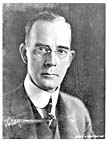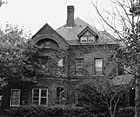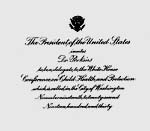

 Director, Eugenics Survey of Vermont, 1925-1936
Director, Eugenics Survey of Vermont, 1925-1936
Professor of Zoology, University of Vermont 1902-1945
Curator, Robert Hull Fleming Museum, 1931-1945
President, American Eugenics Society, 1931-1934
Henry F. Perkins was born in 1877 in Burlington, Vermont, the only son
of George Henry Perkins, Professor of Natural Sciences and Dean of Arts
and Sciences at the University of Vermont and State Geologist and Entomologist.
Harry followed in his father's footsteps to carry on the family tradition
of civic and scientific leadership in Vermont.  He graduated Phi Beta Kappa from UVM in 1898 and received a Ph.D. in Zoology
at Johns Hopkins University in 1902. Upon completion of his dissertation
on the development and life cycle of Gonionema murbachii (a type of
jellyfish), he began teaching Zoology at UVM. He taught biology, entomology,
anatomy and physiology, and embryology during the first half of his career.
He advanced to full professor in 1911 and served as chairman of the Zoology
Department as more faculty were added. His sporadic research projects involved
field studies in the rapidly fading naturalist tradition: studies of birds,
game fish, and marine invertebrates.
He graduated Phi Beta Kappa from UVM in 1898 and received a Ph.D. in Zoology
at Johns Hopkins University in 1902. Upon completion of his dissertation
on the development and life cycle of Gonionema murbachii (a type of
jellyfish), he began teaching Zoology at UVM. He taught biology, entomology,
anatomy and physiology, and embryology during the first half of his career.
He advanced to full professor in 1911 and served as chairman of the Zoology
Department as more faculty were added. His sporadic research projects involved
field studies in the rapidly fading naturalist tradition: studies of birds,
game fish, and marine invertebrates.
 Harry Perkins's interest in human affairs, civic improvement, and social
life in Burlington gradually overshadowed zoological research. With his wife
and two daughters, he lived with his father, Dean George Perkins, in the house
where he had grown up on the affluent "Burlington Hill" next to the University.
As a leader in the YMCA since college days, a Sunday school teacher at the
College Street Congregational Church, and one of the first presidents of
the Boy Scout Council, Perkins solidified his reputation as a community leader
with a strong interest in youth.
Harry Perkins's interest in human affairs, civic improvement, and social
life in Burlington gradually overshadowed zoological research. With his wife
and two daughters, he lived with his father, Dean George Perkins, in the house
where he had grown up on the affluent "Burlington Hill" next to the University.
As a leader in the YMCA since college days, a Sunday school teacher at the
College Street Congregational Church, and one of the first presidents of
the Boy Scout Council, Perkins solidified his reputation as a community leader
with a strong interest in youth.
 In 1922, Professor Perkins revamped the Zoology curriculum and began teaching
courses specifically on Heredity and Evolution. His heredity class provided
the first known venue for eugenics education at UVM and the inspiration for
a "Eugenics Survey" -- a field station to study Vermonters. As Director of
the Eugenics Survey, Harry Perkins emerged as Vermont's resident eugenicist
and dedicated the second half of his career to preserving the Yankee Protestant
stronghold on the identity, the heritage, and the future of Vermont.
In 1922, Professor Perkins revamped the Zoology curriculum and began teaching
courses specifically on Heredity and Evolution. His heredity class provided
the first known venue for eugenics education at UVM and the inspiration for
a "Eugenics Survey" -- a field station to study Vermonters. As Director of
the Eugenics Survey, Harry Perkins emerged as Vermont's resident eugenicist
and dedicated the second half of his career to preserving the Yankee Protestant
stronghold on the identity, the heritage, and the future of Vermont.
Professor Perkins's views on eugenics were sufficiently broad and flexible
to permit him to revise his position on the roles of heredity and environment
when scientific opinion or local sentiments demanded it. In 1927-28, he
took a sabbatical to solicit funding and organize a comprehensive survey
of rural  Vermont, including all aspects of rural life that might explain the causes
and effects of rural decline in the state. The resulting Vermont Commission
on Country Life permitted Perkins to incorporate eugenic agendas into a comprehensive
plan for community development in the state. Perkins served as VCCL secretary
until 1931 and Executive Vice President of the Commission thereafter. In 1930,
Perkins attended the White House Conference on Child Health and Protection
and incorporated their recommended reforms into his eugenics education in
Vermont.
Vermont, including all aspects of rural life that might explain the causes
and effects of rural decline in the state. The resulting Vermont Commission
on Country Life permitted Perkins to incorporate eugenic agendas into a comprehensive
plan for community development in the state. Perkins served as VCCL secretary
until 1931 and Executive Vice President of the Commission thereafter. In 1930,
Perkins attended the White House Conference on Child Health and Protection
and incorporated their recommended reforms into his eugenics education in
Vermont.
In 1931, Perkins was elected president of the American Eugenics Society, an opportunity he used to publicize the accomplishments of Eugenics Survey and the Vermont Commission on Country Life to national audiences. He resigned as president in 1934, but continued to serve on their executive board until his retirement.
 When the Eugenics Survey closed in 1936, Perkins moved its archive and the
records of the Vermont Commission on Country Life to the Robert Hull Fleming
Museum at the University of Vermont, where he served as director from 1931
to 1945. He obtained WPA funds to catalogue and preserve the records for posterity.
Perkins continued to teach eugenics and genetics at UVM until his retirement
in 1945 and remained active in the UVM Alumni Association until his death
in 1956.
When the Eugenics Survey closed in 1936, Perkins moved its archive and the
records of the Vermont Commission on Country Life to the Robert Hull Fleming
Museum at the University of Vermont, where he served as director from 1931
to 1945. He obtained WPA funds to catalogue and preserve the records for posterity.
Perkins continued to teach eugenics and genetics at UVM until his retirement
in 1945 and remained active in the UVM Alumni Association until his death
in 1956.
Henry Perkins's shifting interpretations of eugenics are evident in his writings and speeches. Most of his commentaries and his proposals are found in these sections: